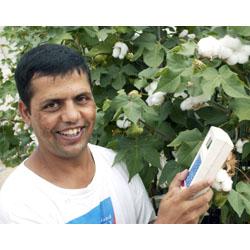Aerated water promising for protecting crops against salinity
Published on 15 January, 2004
Research has shown that subsurface drip irrigation (SDI) with aerated water does improve plant tolerance to salinity and should be viable for commercial crops.
The controlled experiments by Central Queensland University doctoral fellow Surya Bhattarai used an air injector in tandem with the SDI system to deliver an air/water slurry to the root zone of cotton, vegetable soybean and tomato plants.
 The boost in oxygen not only improves the plant performance in saline soils. It also reduces the amount of water needed and boosts the plant\'s ability to protect itself from toxic levels of salts.
The boost in oxygen not only improves the plant performance in saline soils. It also reduces the amount of water needed and boosts the plant\'s ability to protect itself from toxic levels of salts.
"Root membranes play a crucial role, and act as a filter for exclusion of salts in a saline environment," Mr Bhattarai said.
"However, saline soils exacerbate oxygen deficits, which in turn affect the chemical composition and structure of root cell membranes through the decreased membrane fluidity," Mr Bhattarai said.
"Hence the capacity for exclusion of salt by plant is reduced in anoxic soil environments." Mr Bhattarai said aeration of water flowing through the root zone was more uniformly effective and cost efficient than direct injection of air into the root zone.
"With the acceptance of subsurface drip irrigation by industries, the air injection system is applicable to crops under both saline and non-saline soils," he said.
Results of the experiments showed increased aeration offers positive effects on the plant\'s performance irrespective of species.
The results from greater aeration showed higher root activities, greater exclusion of salt from the uptake, an increase in soil respiration rates and increases in the rates of photosynthesis. These enhancements in physiological adaptations were linked with the reduction in membrane leakage.
The study also revealed the salt concentrations in the foliage samples were significantly lower in the aerated treatments.
All in all, the aeration treatment resulted in on average a yield increase in the range of 18-28% over the non-aerated controls.
"It seems promising that the salinity problems of irrigated agriculture can be managed through forced aeration using aerated water on subsurface drip irrigation crops," Mr Bhattarai said. ENDS.
For details contact Surya on Phone: +61 7 4923 2050 or 0438 191 391 E-mail: s.bhattarai@cqu.edu.au Photo: Surya undertakes his controlled experiments.

